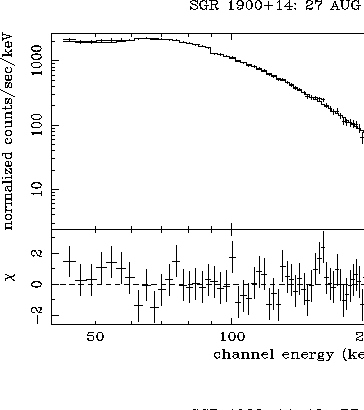



Next: GRBM Spectra.
Up: Soft-Gamma-ray Repeaters
Previous: SGR1900+14: The interesting Case
Contents
To date (Dec 2001), SGR1900+14 is the only known SGR that was responsible
for two giant flares, occurred on August 27, 1998, and April 18, 2001,
respectively. The other giant flare so far detected has come from SGR0526-66,
on March 5, 1979. The simple fact that the same source produced two such
flares within  3 years strongly constrains the models proposed
for such disruptive emissions, especially
regarding the repetition timescales, that after April 2001 turned out to
be shorter than expected (some decades, [Hurley et al., 1999c]).
3 years strongly constrains the models proposed
for such disruptive emissions, especially
regarding the repetition timescales, that after April 2001 turned out to
be shorter than expected (some decades, [Hurley et al., 1999c]).
The GRBM did detect both flares (fig. ![[*]](crossref.png) );
in addition, the 2001 flare occurred in
the field of view of the WFC1, switching it off by rate protection.
The most relevant results obtained for the 1998 flare and an extensive
analysis of the GRBM data have been already reported by [Feroci et al., 1999a,Feroci et al., 2001b]; in particular, the latter work gives an interpretation of
the GRBM-Ulysses data, according to the Magnetar Model.
);
in addition, the 2001 flare occurred in
the field of view of the WFC1, switching it off by rate protection.
The most relevant results obtained for the 1998 flare and an extensive
analysis of the GRBM data have been already reported by [Feroci et al., 1999a,Feroci et al., 2001b]; in particular, the latter work gives an interpretation of
the GRBM-Ulysses data, according to the Magnetar Model.
Figure:
Background subtracted light curves of two giant flares from
SGR1900+14: August 27, 1998 (top), April 18, 2001 (bottom).
The  s modulation is apparent in both cases. In the 1998 case,
the initial spike is affected by the GRBM counters' recycling.
s modulation is apparent in both cases. In the 1998 case,
the initial spike is affected by the GRBM counters' recycling.
 |
In this section, our attention is focused on two main points:
first, an extensive use of the 128 s 240 channel spectra acquired
by the GRBM is now feasible, thanks to the new GRBM response matrix,
that can apply to whatever local direction.
Second, a comparison between the two flares could yield important
constraints for understanding the processes involved and, in
particular, for testing the Magnetar Model; here, we only mention
the topics of an extensive analysis, that is still in progress
(Guidorzi et al., 2002, in preparation).
Table:
Parameters obtained by fitting the GRBM spectra of the
two flares with broken power law plus black body (Guidorzi et al.
interpretation).
| Component |
Parameter |
August 98 (slice B) |
April 01 (slice A) |
| bknpower |
PhotonIndex1 |
 |
 |
| bknpower |
BreakE (keV) |
 |
 |
| bknpower |
PhotonIndex2 |
 |
 |
| bbody |
kT (keV) |
 |
 |
| |
 |
 |
 |
| |
Fluence (40-100 keV) |
 |
 |
| |
(
 ) ) |
|
|
Figure:
GRBM Spectra of the two Giant Flares: August 1998 (slice B) (top) and
April 2001 (slice A) (bottom). Both have been fitted with black body plus
broken power law;  for both cases. (From Guidorzi
et al., 2002, in preparation)
for both cases. (From Guidorzi
et al., 2002, in preparation)
 |
Subsections




Next: GRBM Spectra.
Up: Soft-Gamma-ray Repeaters
Previous: SGR1900+14: The interesting Case
Contents
Cristiano Guidorzi
2003-07-31
![[*]](crossref.png) );
in addition, the 2001 flare occurred in
the field of view of the WFC1, switching it off by rate protection.
The most relevant results obtained for the 1998 flare and an extensive
analysis of the GRBM data have been already reported by [Feroci et al., 1999a,Feroci et al., 2001b]; in particular, the latter work gives an interpretation of
the GRBM-Ulysses data, according to the Magnetar Model.
);
in addition, the 2001 flare occurred in
the field of view of the WFC1, switching it off by rate protection.
The most relevant results obtained for the 1998 flare and an extensive
analysis of the GRBM data have been already reported by [Feroci et al., 1999a,Feroci et al., 2001b]; in particular, the latter work gives an interpretation of
the GRBM-Ulysses data, according to the Magnetar Model.

